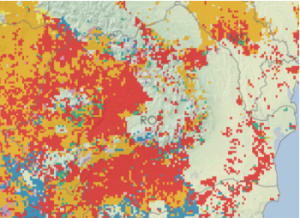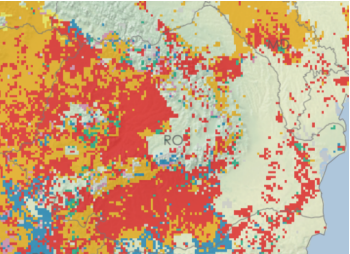Climate Detectives Projects 2022-2023
Project title: Expectation of Droughts in Romania
Team: Vianu Researchers
Tudor Vianu National High School of Computer Science Bucharest Romania 10 Student’s age: 16-17 years old, 18-19 years old
Can we predict when droughts wil happen, or the very least, see the signs of one and expect it, is there a pattern of when they happenn?
Romania has experienced a significant increase in average temperature and numerous droughts in recent years. The aim of our study is to examine whether there is a discernible pattern in the occurrence of these droughts and whether they can be predicted in advance. We also intend to investigate whether air quality and gas emissions in affected areas may contribute to the lack of precipitation.
To achieve this, we will analyze gas emissions such as carbon dioxide (CO2), carbon monoxide (CO), and sulphur dioxide (SO2) in the affected regions leading up to and during the period of drought. Additionally, we will examine the impact of deforestation on water flow and explore the volumetric flow and water level of rivers in the area for any potential correlations with drought occurrences.
Our study will also seek to identify the regions most affected by low precipitation years, and determine common factors such as deforestation and average temperature in those areas. Overall, our goal is to gain a deeper understanding of the relationship between these various factors and their impact on the occurrence of droughts in Romania.

To draw attention to our research, we have chosen to focus on the year 2012 due to several significant factors. Our interest in the drought of 2012 stems from its close association with pollution, deforestation, and river levels.
Firstly, we observed a drop of 1 degree Celsius in average temperature in 2012 compared to the previous year, making it the lowest average temperature recorded from 2009 to 2015. Additionally, 2012 saw the lowest precipitation levels in the past 15 years, which contributed to the severity of the drought. These drought conditions were further exacerbated by the highest levels of gas emissions recorded in the past 15 years and a significant decrease in the water level of rivers. Furthermore, 2012 also experienced the second-highest level of deforestation in the past 20 years.
Overall, our findings suggest a strong correlation between the water level of rivers, air pollution, deforestation, and droughts. The case of 2012 provides a notable example of how these factors can combine to create severe drought conditions.
Afterall, our findings indicate that multiple factors can contribute to the occurrence and severity of droughts. By identifying these patterns, we can develop strategies to mitigate the impact of droughts in affected regions.
In conclusion, our research highlights the need for immediate action to mitigate the impact of droughts. To address this, we recommend taking the following steps.
Firstly, it is crucial to protect our forests. Trees play a vital role in the natural water cycle and soil health, and therefore excessive deforestation must be avoided. If necessary, we should plant new trees to replace those that have been cut down. Planting trees without cutting them down in the first place is also a great idea to preserve our forests.
Secondly, we need to reduce air pollution to maintain the freshness of the air and the health of the environment. Reducing gas emissions is key to achieving this, and it can be accomplished in many ways. For instance, we can modernize infrastructural plants to reduce their emissions, use cars less often, or switch to environmentally-friendly modes of transportation.
In conclusion, it is vital to take immediate action to mitigate the impact of droughts. By protecting our forests and reducing air pollution, we can make a significant contribution towards this goal.
CAN-WE-PREDICT-A-DROUGHT-BY-STUDYING-THE-ENVIRONMENT-1.pdf
Projects are created by the teams and they take the full responsibility of the shared data.
← All projects




